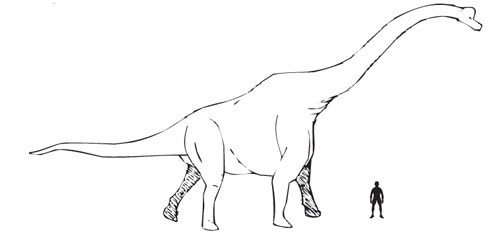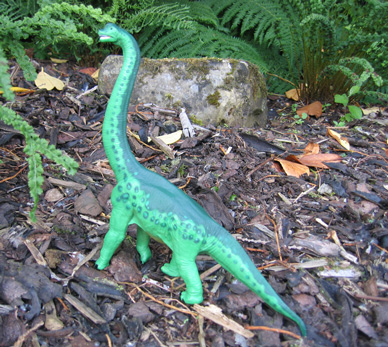Should Brachiosaurus be called Giraffatitan?
Brachiosaurus is one of the most popular dinosaurs with young dinosaur fans. It normally rates quite highly in the annual Everything Dinosaur most popular prehistoric animals survey. Brachiosaurus has not quite made the top ten yet, but it tends to be placed in the top twenty of children’s favourites.
To read more about our annual survey: Top Ten most popular Prehistoric Animals 2007/8
However, researchers studying an ancient dinosaur skull found nearly 100 years ago, could challenge much of what we know about Brachiosaurus and their work may even result in a name change for some fossils of this dinosaur.
Brachiosaurus
Brachiosaurs were sauropods (large, long-necked dinosaurs) that lived during the Late Jurassic and Early Cretaceous. The name brachiosaur (pronounced brak-ee-oh-saw-us), means “arm lizard”, brachiosaurs had front legs that were longer than their back legs. The back sloped downwards towards (by sauropod standards), a relatively short tail. Brachiosaurs were the “giraffes” of the Mesozoic, their long stiff necks enabled them to reach high into the tops of trees to browse. This gave them access to a food supply that was out of reach of most other dinosaurs. Other sauropods could have fed on the tops of conifers and such like too, but they could only have reached the uppermost branches by rearing up or simply bulldozing the trees to the ground with their massive bulk.
A Typical Illustration of Brachiosaurus

Picture credit: Everything Dinosaur
Huge Animals
Estimates of the maximum size of these huge creatures vary; with weights of between 15 and 78 tonnes being put forward by scientific authors. There is some consensus that the very largest specimens may have weighed between 50-70 tonnes, even at the lower end of the scale this is getting on for ten times the weight of an adult African elephant.
Despite this animal’s great size, its fossils are relatively rare. Such big bones would have been difficult for scavengers to damage and remove from the rest of the carcase. Large bones such as the limb bones and vertebrae could have withstood considerable abrasion before finally getting the chance to be fossilised. A large Brachiosaurus, perhaps drowned in a flood event could float (large amount of gas in the digestive tract), and be transported many miles before finally coming to rest. With luck the body could become covered with sediments and the slow process of fossilisation could start. Of course this is just speculation, the fossil record for Brachiosaurus is particularly poor. Even the extremely fossil rich Morrison Formation of the western USA has provided only one or two fossils of Brachiosaurus. Perhaps these animals were less common than other sauropods such as the diplodocids, or perhaps they inhabited parts of the eco-system where the chance of fossilisation was much less. The result is that scientists have very little fossil material of brachiosaurs to work on, despite these animals being one of the largest dinosaurs of all.
Brachiosaurus was named and described in 1903, by the palaeontologist Elmer Riggs, following study of two partial skeletons discovered in the Grand River Valley of Colorado, USA. Although far from complete, these fossils indicated that this was a new type of dinosaur and so the Brachiosaurus genus came into being.
For a number of years, scientists claimed that such large and heavy creatures could not possibly have been able to move around on land. This led to the sauropods being depicted as semi-aquatic animals, spending much of their time in lakes and swamps where the water could help support their huge weight. This theory has now largely been dismissed and sauropods are depicted as entirely terrestrial animals. The relatively high nostrils had convinced many scientists that these animals lived like giant hippopotami, peacefully feeding on soft, lush water plants away from predators.
To read more about the problems with sauropod nostrils: Where on Diplodocus was its nose?
Picture credit: Everything Dinosaur
Animals at Home in Water
Dinosaur text books of the 1950s-1980s depicted these dinosaurs as semi-aquatic animals with brachiosaurs and other sauropods being depicted as water dwellers. One of the reasons for this assumption can be traced back to studies of sauropod trackways. Many of the fossil footprints had been made in soft mud, indicating that these animals were walking over wet ground, perhaps indicating that they were in a watery environment. Soft mud is an ideal medium for preservation of prints, the fact that these animals walked over dry land as well could not be proved as there were no footprints fossilised to show this. Bizarre logic, as prints are only preserved under exceptional conditions and are most unlikely to be preserved in dry conditions. The absence of any tail marks in the mud where these animals walked was also noticed. This added credence to the theory of the water living dinosaurs, as this was interpreted as the heavy tails being lifted clear of the ground and being buoyed up by the supporting water. The prints were thus interpreted as showing these heavy animals walking along the bottom of lakes and rivers.
The best preserved and most complete fossils of brachiosaurids have been found in Africa. Between 1909 and 1912 a German led expedition to the Tendaguru beds in what was to become Tanzania, uncovered a number of brachiosaurid fossils. More than 30 individual brachiosaurs were found and excavated over this period. Most of the fossils were shipped back to Germany and although some were destroyed in the Second World War, brachiosaur fossils from these expeditions are still on display today.
The huge, mounted skeleton of a brachiosaur in the Humboldt Museum in Berlin is a composite reconstruction using fossils found during the Tendagura expeditions. This is one of the largest mounted dinosaur skeletons in the world. It is in fact made up from the remains of a least five individuals and has recently undergone something of a makeover as our knowledge of brachiosaur anatomy has improved.
To read more about the work undertaken to reconstruct the mounted skeleton of a brachiosaur in the Humboldt museum: Humboldt Brachiosaur gets a Face Lift.
In 1988, palaeontologist and highly talented illustrator Gregory S. Paul, compared the anatomies of the African brachiosaurs (Tendaguru remains) with those found in the western USA. He noted that there were a number of anatomical differences between the two fossil groups, although they supposedly represented the same species Brachiosaurus brancai.
Brachiosaurus and Giraffatitan
The African form seemed more gracile in appearance, it looked more lightly built than its American contemporaries. Another difference was noted in the size and proportion of some of the vertebrae. Paul reinterpreted the fossil evidence and suggested that the African Brachiosaur was sufficiently different from the American fossils to merit being put into its own subgenus. During the Late Jurassic, Africa and the Americas were joined together into a super-continent, the Atlantic ocean that separates these areas of land today had only just begun to form. It was possible to walk from what was to become Antarctica right up to the north of Canada. It had been thought that the genus Brachiosaurus covered both the American and African forms, but Paul’s work was supported by another palaeontologist George Olshevsky and slowly the idea of a separate brachiosaurid genus for the African type began to take hold amongst some scientists. The African brachiosaur was tentatively called Giraffatitan (the name is pronounced ji-raf-ah-ti-tan), it means “Titan Giraffe” very apt as the brachiosaur was regarded as filling a similar environmental niche as modern Giraffes.
The recent find of new American brachiosaur material may help scientists to determine whether or not Giraffatitan is a valid genus, at the moment the classification of brachiosaurid remains as Giraffatitan is still controversial, Giraffatitan is regarded as a synonym for Brachiosaurus by the majority of palaeontologists. In classification terms a synonym is simply another name for the same organism. There are senior and junior synonyms, in this case the name Brachiosaurus would be the senior synonym (first used in 1903) and Giraffatitan the junior synonym.
The recent discovery of a new dinosaur bone bed in the Morrison Formation may provide more data on the American brachiosaurs to aid comparison between the African and American animals. This discovery, announced earlier this week is a fossil “log jam” a series of dinosaur fossils trapped together with a whole host of other fossil remains after a flood, or series of flood events.
To read more about this discovery: New Dinosaur “Log jam” discovered in the Morrison Formation.
It is believed that there are brachiosaur fossils amongst the new finds, this may help provide more information and help to resolve this issue amongst palaeontologists. Ideally, more skull material would be found, this would enable further differences between the two species to be established and perhaps lead to many of the fossil specimens labelled Brachiosaurus in museum collections being relabelled as Giraffatitan.
Other skull material is currently being studied, a partial North American brachiosaurid skull found nearly 100 years ago has been studied by a number of researchers. This skull is more box-like and lacks the distinctive high-crested appearance of the B. brancai holotype. Skull material can prove to be very diagnostic and help determine differences between species. If this skull is confirmed as being from a Brachiosaur such as the North American B. altithorax this would aid weight to the argument for permitting the establishment of Giraffatitan as a separate and distinct genus.
More brachiosaur remains will be found in the future, both in the USA and Africa, so hopefully the taxonomy of these huge reptiles will one day be a little clearer.
Everything Dinosaur stocks a wide range of sauropod figures, such as those in the Wild Safari Prehistoric World model range: Wild Safari Prehistoric World Models.







Leave A Comment